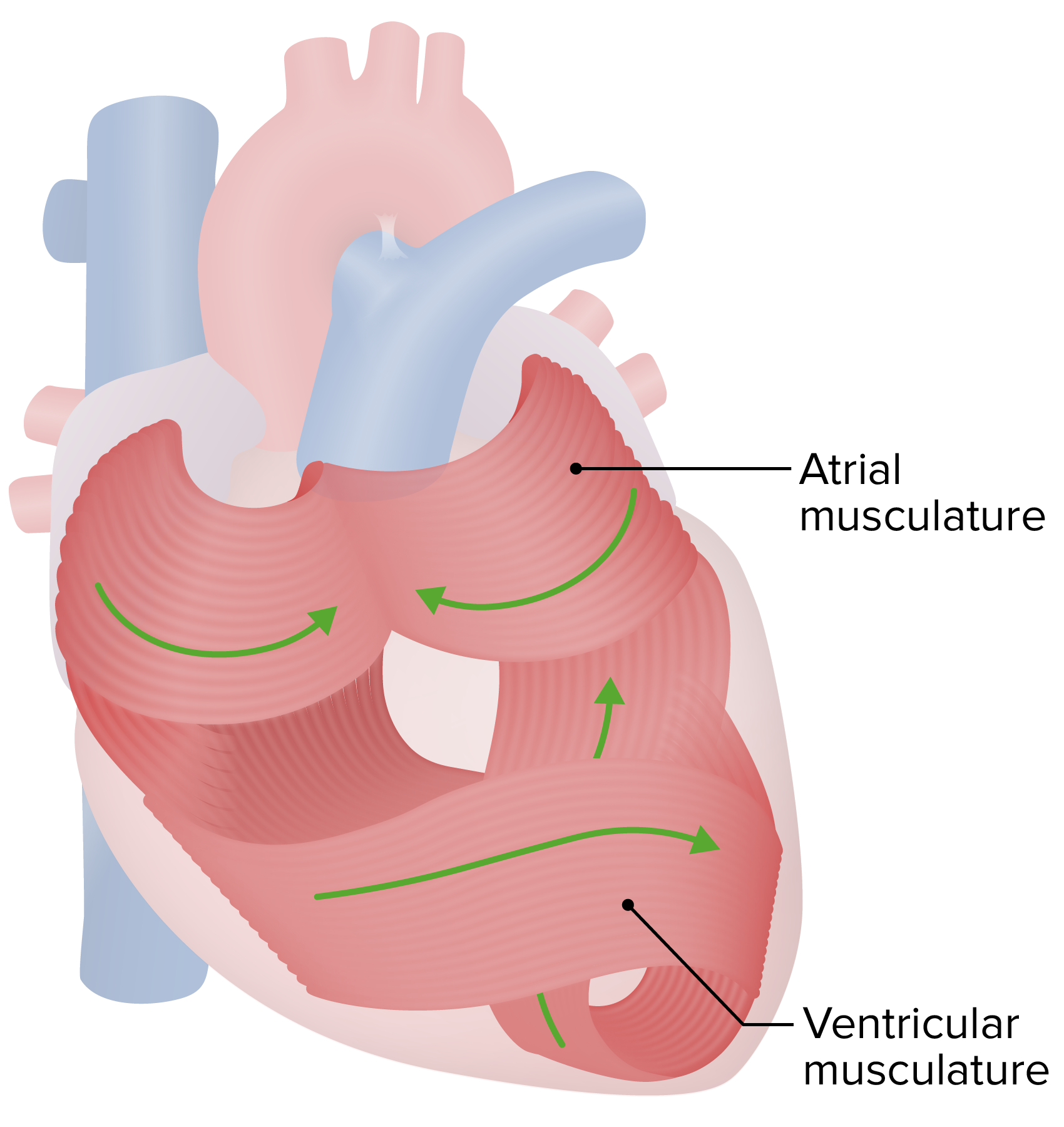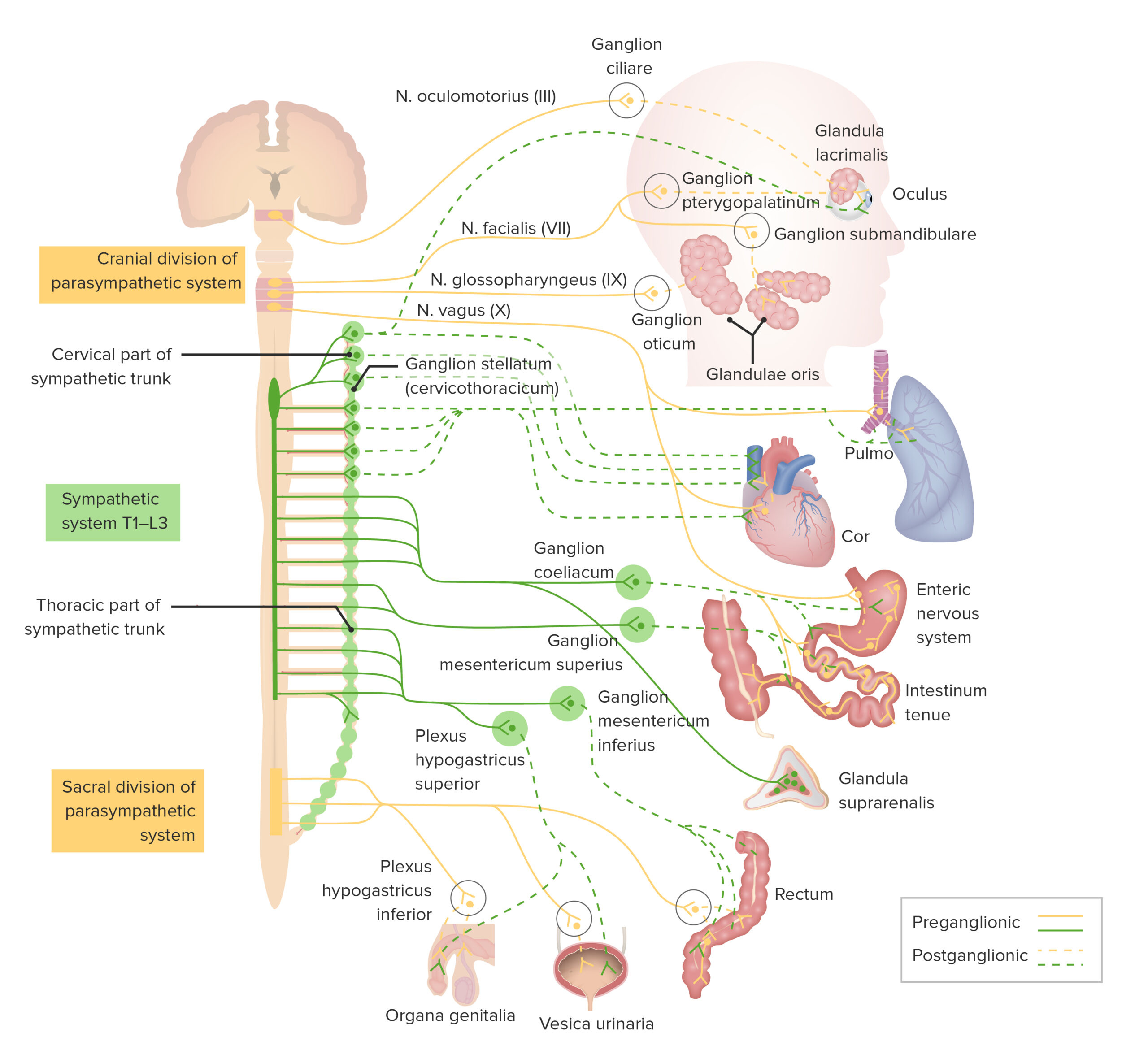Playlist
Show Playlist
Hide Playlist
Effectors of the Autonomic Nervous System (ANS)
-
Slides 07 AutonomicEffectors NervousSystem.pdf
-
Download Lecture Overview
00:01 Autonomic Nervous System Effectors. 00:05 Now, we get to talk a lot about all this different things that happen throughout the body that will able to be doing something. 00:13 We are not just going to look at things, we are going to look at action today. 00:20 The Autonomic Nervous System is a large cohort that’s controlling a number of aspects of the body. 00:28 What we have here are two different columns. 00:31 These are spinal cord columns. 00:34 The first one is the autonomic nervous systems, sympathetic component. 00:39 And then, on the other side, we have the parasympathetic component. 00:44 The sympathetic component you know because it has paravertebral chain ganglia on both sides of the spinal cord. 00:53 This will act as relay spots and sometimes where the soma or cell body of the nerve will be. 01:02 The parasympathetic nervous system, remember, primarily comes from cranial nerve number 10. 01:09 So this vagus nerve will innervate many of the different organs of the body. 01:14 These are the same organs that would innervated by those particular sympathetic fibers that come off of the spinal cord. 01:22 In the parasympathetic nervous system then you also have the splanchnic nerve and some that come from the sacral area. 01:29 And they will innervate things like the bottom portion of the GI track, places like the bladder and the reproductive organs. 01:38 So we go through this process, I think it’s best to do this one organ at a time. 01:44 And so, we do one organ, the next organ, and keep going through those. 01:48 We’ll talk about what’s the function that’s involve, as well as what receptors will mediate that particular function. 01:56 Let’s start off with the heart. 02:00 The heart is going to be innovated by both the sympathetic and parasympathetic nervous system. 02:07 The SA node, and this is again the area that’s going to control heart rate. 02:13 If it’s engage by the sympathetic nervous system it’s through Beta-1 (β1) adrenergic receptors, and this will increase heart rate. 02:24 In contrast, the parasympathetic nervous system, is mediated through muscarinic receptors and that decreases heart rate. 02:35 The conduction system of the heart especially around the AV node, velocity can change in response to sympathetic comparison sympathetic stimulation. 02:47 Beta-adrenergic receptors here also increase conduction velocity in the sympathetic nervous system. 02:54 While muscarinic receptors, this decrease the conduction velocity. 03:00 In terms of contractility, which is the contraction, the strength of the heart, this is gonna be mediated also by beta-adrenergic receptors. 03:11 But now, this increases contractility or an atrophy. 03:16 Muscarinic reflects don’t really have anything to do with the ventricles, to push blood around to the body or to the lungs. 03:25 What happens to the blood flow that goes to the skin in the muscle? Here we need to talk through which things cause constrictions and dilations. 03:37 So in the skin, we mainly have alpha-adrenergic receptors that cause vasoconstriction. 03:44 So vasoconstriction is going to be decreasing the luminal diameter of a blood vessel that reduces the amount of blood flow. 03:54 Beta-2 (β2) adrenergic receptors are located in skeletal muscle and they can cause a vasodilation. 04:02 That said, they are usually not engaged in normal physiology. 04:06 You have to give us supra physiological dose of a drug to get this receptors to be in acted. 04:13 So normally, our response is having a vasoconstriction in response the blood vessels of skeletal muscle. 04:21 So you vasoconstrict them in terms of the sympathetic nervous systems response. 04:26 Hopefully, you’ve looked now on the parasympathetic side and notice there is no intervention of blood vessels to the skin or to the muscle from the parasympathetic nervous system. 04:40 That’s said, there are some relaxing factors that can be released. 04:45 And some of this have been associated with some parasympathetic innervation especially in the facial region. 04:52 The Autonomic Nervous System and the Lung. 04:56 So what changes happen with the lung in regards to a sympathetic and parasympathetic nervous system? The main component with the lung are the bronchioles. 05:06 If you dilated a bronchiole, what will get is an increase in a diameter. 05:12 And if you have an increase in diameter, you'll have a reduction and a resistance and therefore more flow. 05:19 And this sympathetic nervous system does just that by dilating bronchioles. 05:26 It does that through beta-adrenergic receptors. 05:29 The opposite response is a constriction. 05:32 And this is mediated by this parasympathetic nervous system through muscarinic receptors. 05:38 It should be noted that bronchodilation is part of the sympathetic response, but it doesn't occur through direct nerve stimulation of the bronchioles. 05:46 Instead, it's primarily a hormonal effect of sympathetic activation. 05:51 During sympathetic activation, the adrenal medulla releases catecholamines (mainly epinephrine) into the bloodstream. 06:00 These circulating catecholamines then bind to and activate the β2 receptors on the bronchioles, causing dilation. 06:07 Parasympathetic stimulation involves direct innervation of the bronchioles by the vagus nerve, which releases acetylcholine that binds to muscarinic receptors on the airway smooth muscle, leading to bronchoconstriction. 06:18 leading to bronchoconstriction.
About the Lecture
The lecture Effectors of the Autonomic Nervous System (ANS) by Thad Wilson, PhD is from the course Neurophysiology. It contains the following chapters:
- Effectors of the ANS
- ANS - Heart
- ANS - Skin & Muscle Blood Vessels
- ANS - Lung
Included Quiz Questions
Which of the following receptors in the sympathetic nervous system increases the heart rate when engaged?
- Beta-1 adrenergic receptors
- Nicotinic receptors
- Muscarinic type 1 receptors
- Beta-2 adrenergic receptors
- Muscarinic type 2 receptors
Which of the following nerves is an important component of the parasympathetic nervous system?
- Vagus
- Facial
- Abducens
- Glossopharyngeal
- Oculomotor
Which of the following receptors induces vasoconstriction of blood vessels in the skin when engaged?
- Alpha adrenergic
- Beta-1 adrenergic
- Nicotinic
- Muscarinic type 1
- Beta-2 adrenergic
Which of the following receptors of the sympathetic system induces bronchiolar dilation when engaged?
- Beta adrenergic
- Nicotinic
- Muscarinic type 1
- Muscarinic type 2
- Alpha adrenergic
Customer reviews
5,0 of 5 stars
| 5 Stars |
|
5 |
| 4 Stars |
|
0 |
| 3 Stars |
|
0 |
| 2 Stars |
|
0 |
| 1 Star |
|
0 |





